Wireless Networking Concepts Assignment Solution - Semester X, Year Y
VerifiedAdded on 2022/12/20
|8
|1291
|63
Homework Assignment
AI Summary
This assignment solution delves into key concepts of wireless networking, addressing questions on cell splitting, channel reuse, and cellular design. The solution explains the phenomenon of cell splitting in overcrowded networks, detailing how cells are subdivided and the implications for base station placement and channel allocation. It provides calculations for distance reuse, channel capacity, and Erlang traffic analysis. The assignment further explores different cellular design approaches, including edge-excited and center-excited cells, discussing their characteristics, advantages, and suitability for various environments (urban vs. rural). The solution offers design proposals and justifications for the chosen cellular layouts, considering factors such as frequency reuse, capacity demands, and cost-effectiveness. The document references relevant research papers to support the analysis and design choices. This assignment is designed to help students understand and apply the fundamental principles of wireless network architecture and performance analysis.
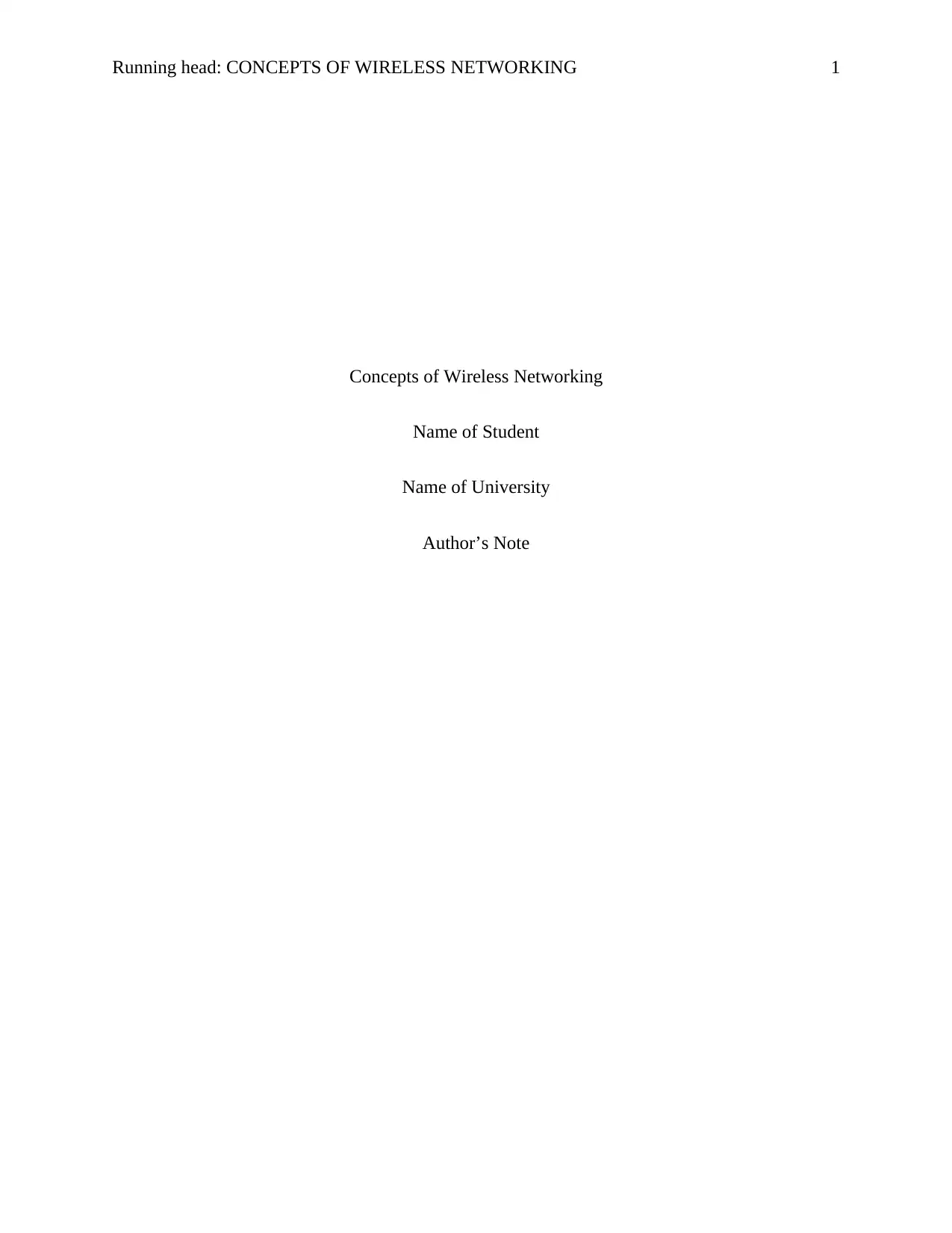
Running head: CONCEPTS OF WIRELESS NETWORKING 1
Concepts of Wireless Networking
Name of Student
Name of University
Author’s Note
Concepts of Wireless Networking
Name of Student
Name of University
Author’s Note
Paraphrase This Document
Need a fresh take? Get an instant paraphrase of this document with our AI Paraphraser
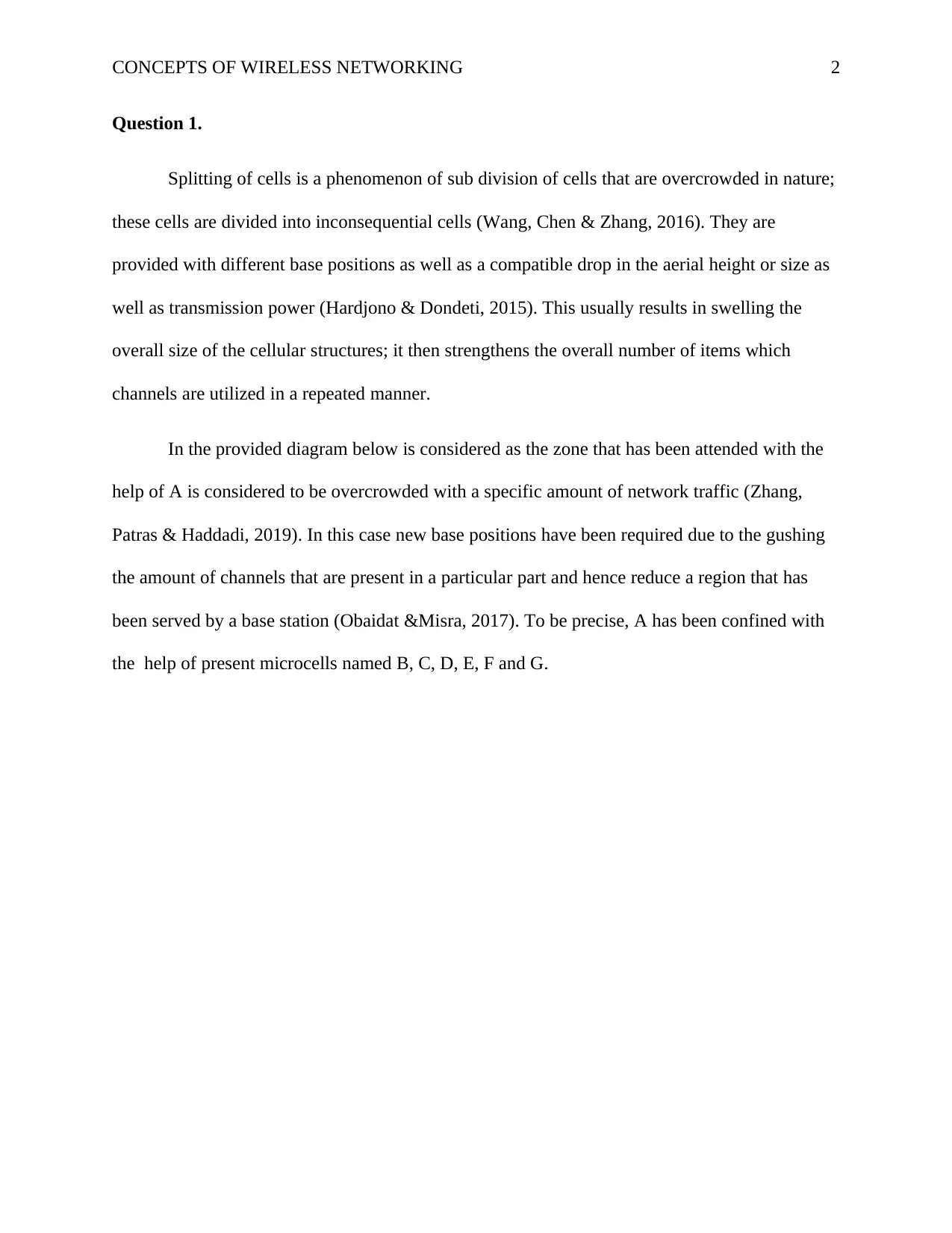
CONCEPTS OF WIRELESS NETWORKING 2
Question 1.
Splitting of cells is a phenomenon of sub division of cells that are overcrowded in nature;
these cells are divided into inconsequential cells (Wang, Chen & Zhang, 2016). They are
provided with different base positions as well as a compatible drop in the aerial height or size as
well as transmission power (Hardjono & Dondeti, 2015). This usually results in swelling the
overall size of the cellular structures; it then strengthens the overall number of items which
channels are utilized in a repeated manner.
In the provided diagram below is considered as the zone that has been attended with the
help of A is considered to be overcrowded with a specific amount of network traffic (Zhang,
Patras & Haddadi, 2019). In this case new base positions have been required due to the gushing
the amount of channels that are present in a particular part and hence reduce a region that has
been served by a base station (Obaidat &Misra, 2017). To be precise, A has been confined with
the help of present microcells named B, C, D, E, F and G.
Question 1.
Splitting of cells is a phenomenon of sub division of cells that are overcrowded in nature;
these cells are divided into inconsequential cells (Wang, Chen & Zhang, 2016). They are
provided with different base positions as well as a compatible drop in the aerial height or size as
well as transmission power (Hardjono & Dondeti, 2015). This usually results in swelling the
overall size of the cellular structures; it then strengthens the overall number of items which
channels are utilized in a repeated manner.
In the provided diagram below is considered as the zone that has been attended with the
help of A is considered to be overcrowded with a specific amount of network traffic (Zhang,
Patras & Haddadi, 2019). In this case new base positions have been required due to the gushing
the amount of channels that are present in a particular part and hence reduce a region that has
been served by a base station (Obaidat &Misra, 2017). To be precise, A has been confined with
the help of present microcells named B, C, D, E, F and G.
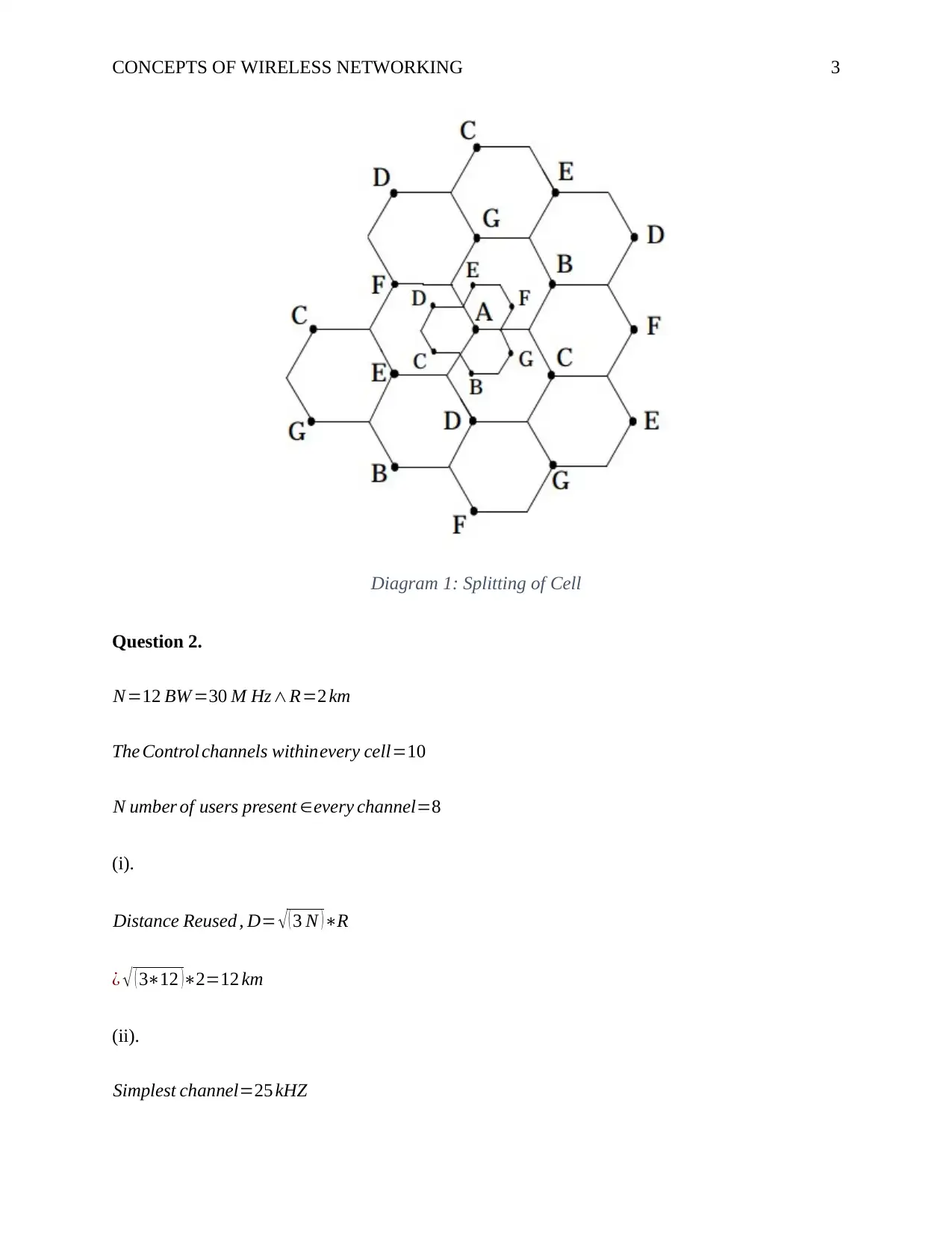
CONCEPTS OF WIRELESS NETWORKING 3
Diagram 1: Splitting of Cell
Question 2.
N=12 BW =30 M Hz∧R=2 km
The Control channels withinevery cell=10
N umber of users present ∈every channel=8
(i).
Distance Reused , D= √ ( 3 N )∗R
¿ √ ( 3∗12 )∗2=12 km
(ii).
Simplest channel=25 kHZ
Diagram 1: Splitting of Cell
Question 2.
N=12 BW =30 M Hz∧R=2 km
The Control channels withinevery cell=10
N umber of users present ∈every channel=8
(i).
Distance Reused , D= √ ( 3 N )∗R
¿ √ ( 3∗12 )∗2=12 km
(ii).
Simplest channel=25 kHZ
⊘ This is a preview!⊘
Do you want full access?
Subscribe today to unlock all pages.

Trusted by 1+ million students worldwide
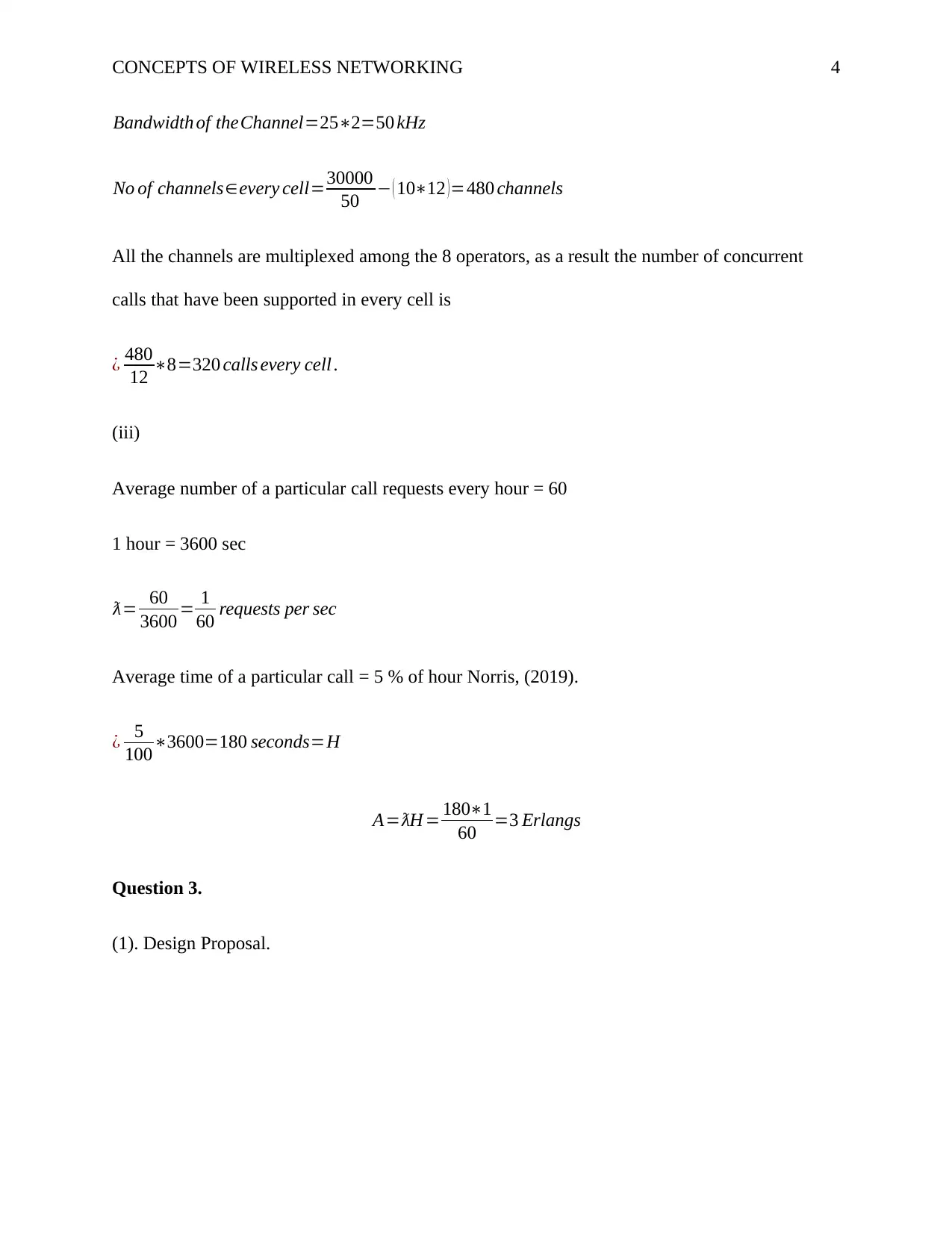
CONCEPTS OF WIRELESS NETWORKING 4
Bandwidth of theChannel=25∗2=50 kHz
No of channels∈every cell=30000
50 − ( 10∗12 )=480 channels
All the channels are multiplexed among the 8 operators, as a result the number of concurrent
calls that have been supported in every cell is
¿ 480
12 ∗8=320 calls every cell .
(iii)
Average number of a particular call requests every hour = 60
1 hour = 3600 sec
ƛ= 60
3600 = 1
60 requests per sec
Average time of a particular call = 5 % of hour Norris, (2019).
¿ 5
100∗3600=180 seconds=H
A=ƛH = 180∗1
60 =3 Erlangs
Question 3.
(1). Design Proposal.
Bandwidth of theChannel=25∗2=50 kHz
No of channels∈every cell=30000
50 − ( 10∗12 )=480 channels
All the channels are multiplexed among the 8 operators, as a result the number of concurrent
calls that have been supported in every cell is
¿ 480
12 ∗8=320 calls every cell .
(iii)
Average number of a particular call requests every hour = 60
1 hour = 3600 sec
ƛ= 60
3600 = 1
60 requests per sec
Average time of a particular call = 5 % of hour Norris, (2019).
¿ 5
100∗3600=180 seconds=H
A=ƛH = 180∗1
60 =3 Erlangs
Question 3.
(1). Design Proposal.
Paraphrase This Document
Need a fresh take? Get an instant paraphrase of this document with our AI Paraphraser
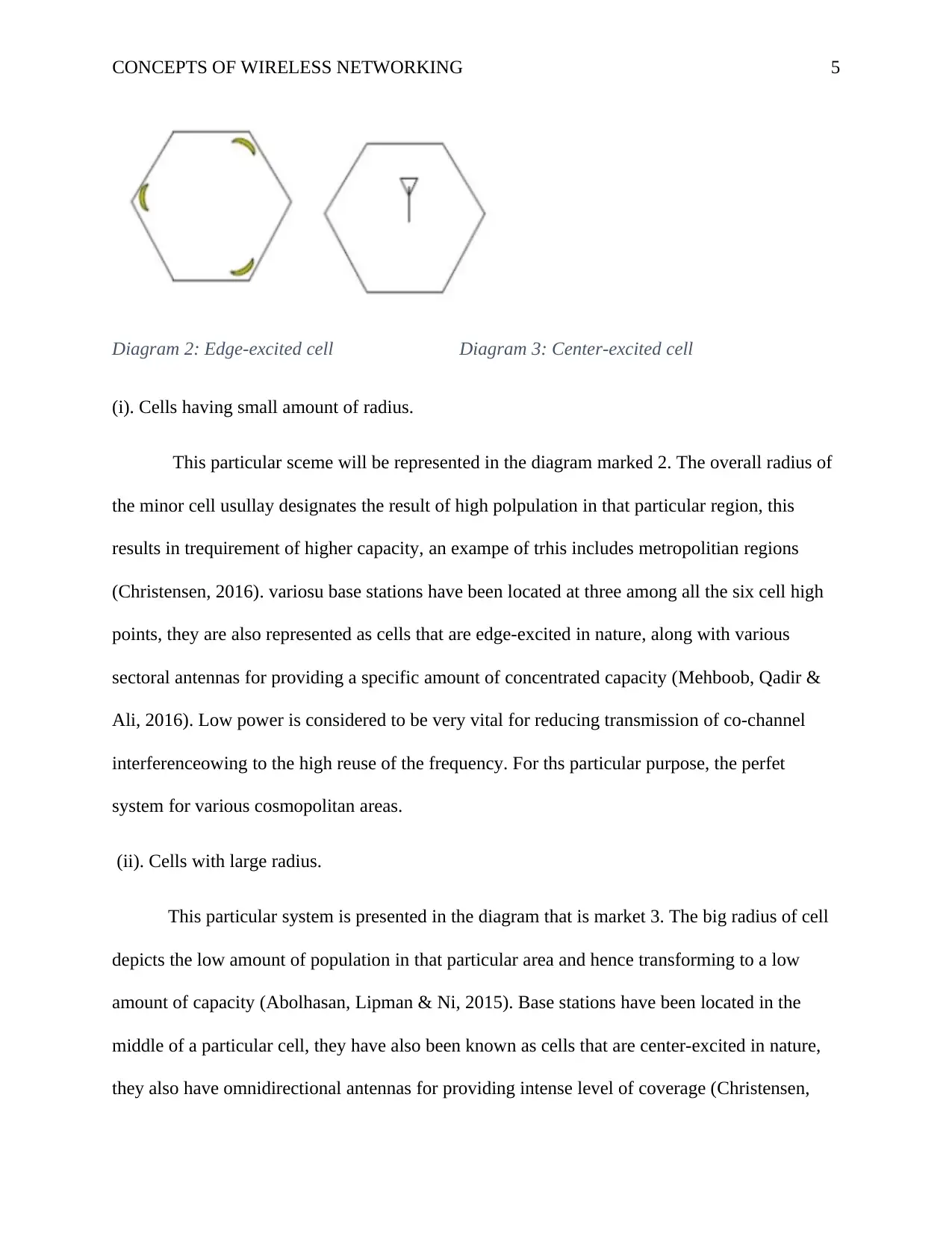
CONCEPTS OF WIRELESS NETWORKING 5
Diagram 2: Edge-excited cell Diagram 3: Center-excited cell
(i). Cells having small amount of radius.
This particular sceme will be represented in the diagram marked 2. The overall radius of
the minor cell usullay designates the result of high polpulation in that particular region, this
results in trequirement of higher capacity, an exampe of trhis includes metropolitian regions
(Christensen, 2016). variosu base stations have been located at three among all the six cell high
points, they are also represented as cells that are edge-excited in nature, along with various
sectoral antennas for providing a specific amount of concentrated capacity (Mehboob, Qadir &
Ali, 2016). Low power is considered to be very vital for reducing transmission of co-channel
interferenceowing to the high reuse of the frequency. For ths particular purpose, the perfet
system for various cosmopolitan areas.
(ii). Cells with large radius.
This particular system is presented in the diagram that is market 3. The big radius of cell
depicts the low amount of population in that particular area and hence transforming to a low
amount of capacity (Abolhasan, Lipman & Ni, 2015). Base stations have been located in the
middle of a particular cell, they have also been known as cells that are center-excited in nature,
they also have omnidirectional antennas for providing intense level of coverage (Christensen,
Diagram 2: Edge-excited cell Diagram 3: Center-excited cell
(i). Cells having small amount of radius.
This particular sceme will be represented in the diagram marked 2. The overall radius of
the minor cell usullay designates the result of high polpulation in that particular region, this
results in trequirement of higher capacity, an exampe of trhis includes metropolitian regions
(Christensen, 2016). variosu base stations have been located at three among all the six cell high
points, they are also represented as cells that are edge-excited in nature, along with various
sectoral antennas for providing a specific amount of concentrated capacity (Mehboob, Qadir &
Ali, 2016). Low power is considered to be very vital for reducing transmission of co-channel
interferenceowing to the high reuse of the frequency. For ths particular purpose, the perfet
system for various cosmopolitan areas.
(ii). Cells with large radius.
This particular system is presented in the diagram that is market 3. The big radius of cell
depicts the low amount of population in that particular area and hence transforming to a low
amount of capacity (Abolhasan, Lipman & Ni, 2015). Base stations have been located in the
middle of a particular cell, they have also been known as cells that are center-excited in nature,
they also have omnidirectional antennas for providing intense level of coverage (Christensen,
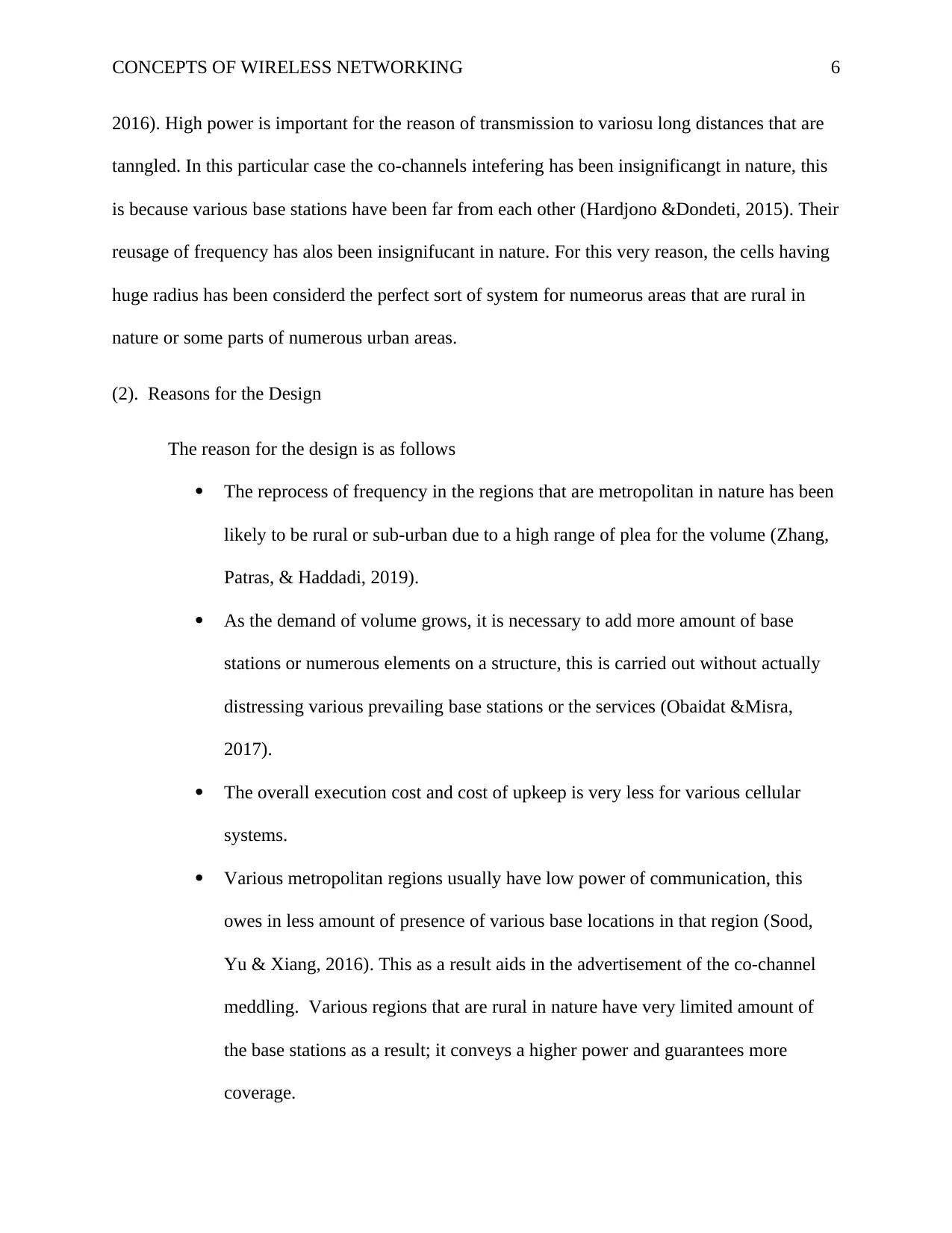
CONCEPTS OF WIRELESS NETWORKING 6
2016). High power is important for the reason of transmission to variosu long distances that are
tanngled. In this particular case the co-channels intefering has been insignificangt in nature, this
is because various base stations have been far from each other (Hardjono &Dondeti, 2015). Their
reusage of frequency has alos been insignifucant in nature. For this very reason, the cells having
huge radius has been considerd the perfect sort of system for numeorus areas that are rural in
nature or some parts of numerous urban areas.
(2). Reasons for the Design
The reason for the design is as follows
The reprocess of frequency in the regions that are metropolitan in nature has been
likely to be rural or sub-urban due to a high range of plea for the volume (Zhang,
Patras, & Haddadi, 2019).
As the demand of volume grows, it is necessary to add more amount of base
stations or numerous elements on a structure, this is carried out without actually
distressing various prevailing base stations or the services (Obaidat &Misra,
2017).
The overall execution cost and cost of upkeep is very less for various cellular
systems.
Various metropolitan regions usually have low power of communication, this
owes in less amount of presence of various base locations in that region (Sood,
Yu & Xiang, 2016). This as a result aids in the advertisement of the co-channel
meddling. Various regions that are rural in nature have very limited amount of
the base stations as a result; it conveys a higher power and guarantees more
coverage.
2016). High power is important for the reason of transmission to variosu long distances that are
tanngled. In this particular case the co-channels intefering has been insignificangt in nature, this
is because various base stations have been far from each other (Hardjono &Dondeti, 2015). Their
reusage of frequency has alos been insignifucant in nature. For this very reason, the cells having
huge radius has been considerd the perfect sort of system for numeorus areas that are rural in
nature or some parts of numerous urban areas.
(2). Reasons for the Design
The reason for the design is as follows
The reprocess of frequency in the regions that are metropolitan in nature has been
likely to be rural or sub-urban due to a high range of plea for the volume (Zhang,
Patras, & Haddadi, 2019).
As the demand of volume grows, it is necessary to add more amount of base
stations or numerous elements on a structure, this is carried out without actually
distressing various prevailing base stations or the services (Obaidat &Misra,
2017).
The overall execution cost and cost of upkeep is very less for various cellular
systems.
Various metropolitan regions usually have low power of communication, this
owes in less amount of presence of various base locations in that region (Sood,
Yu & Xiang, 2016). This as a result aids in the advertisement of the co-channel
meddling. Various regions that are rural in nature have very limited amount of
the base stations as a result; it conveys a higher power and guarantees more
coverage.
⊘ This is a preview!⊘
Do you want full access?
Subscribe today to unlock all pages.

Trusted by 1+ million students worldwide
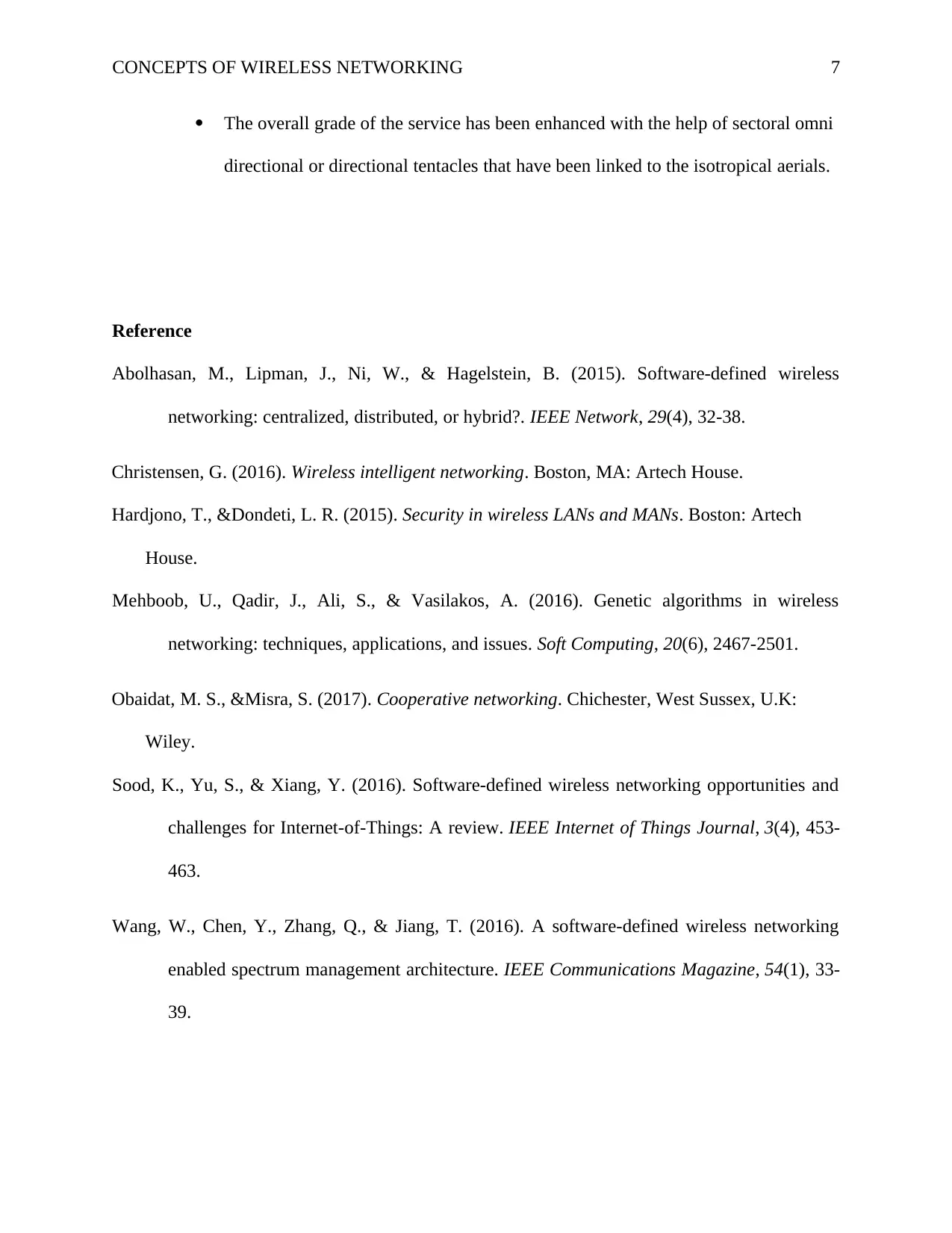
CONCEPTS OF WIRELESS NETWORKING 7
The overall grade of the service has been enhanced with the help of sectoral omni
directional or directional tentacles that have been linked to the isotropical aerials.
Reference
Abolhasan, M., Lipman, J., Ni, W., & Hagelstein, B. (2015). Software-defined wireless
networking: centralized, distributed, or hybrid?. IEEE Network, 29(4), 32-38.
Christensen, G. (2016). Wireless intelligent networking. Boston, MA: Artech House.
Hardjono, T., &Dondeti, L. R. (2015). Security in wireless LANs and MANs. Boston: Artech
House.
Mehboob, U., Qadir, J., Ali, S., & Vasilakos, A. (2016). Genetic algorithms in wireless
networking: techniques, applications, and issues. Soft Computing, 20(6), 2467-2501.
Obaidat, M. S., &Misra, S. (2017). Cooperative networking. Chichester, West Sussex, U.K:
Wiley.
Sood, K., Yu, S., & Xiang, Y. (2016). Software-defined wireless networking opportunities and
challenges for Internet-of-Things: A review. IEEE Internet of Things Journal, 3(4), 453-
463.
Wang, W., Chen, Y., Zhang, Q., & Jiang, T. (2016). A software-defined wireless networking
enabled spectrum management architecture. IEEE Communications Magazine, 54(1), 33-
39.
The overall grade of the service has been enhanced with the help of sectoral omni
directional or directional tentacles that have been linked to the isotropical aerials.
Reference
Abolhasan, M., Lipman, J., Ni, W., & Hagelstein, B. (2015). Software-defined wireless
networking: centralized, distributed, or hybrid?. IEEE Network, 29(4), 32-38.
Christensen, G. (2016). Wireless intelligent networking. Boston, MA: Artech House.
Hardjono, T., &Dondeti, L. R. (2015). Security in wireless LANs and MANs. Boston: Artech
House.
Mehboob, U., Qadir, J., Ali, S., & Vasilakos, A. (2016). Genetic algorithms in wireless
networking: techniques, applications, and issues. Soft Computing, 20(6), 2467-2501.
Obaidat, M. S., &Misra, S. (2017). Cooperative networking. Chichester, West Sussex, U.K:
Wiley.
Sood, K., Yu, S., & Xiang, Y. (2016). Software-defined wireless networking opportunities and
challenges for Internet-of-Things: A review. IEEE Internet of Things Journal, 3(4), 453-
463.
Wang, W., Chen, Y., Zhang, Q., & Jiang, T. (2016). A software-defined wireless networking
enabled spectrum management architecture. IEEE Communications Magazine, 54(1), 33-
39.
Paraphrase This Document
Need a fresh take? Get an instant paraphrase of this document with our AI Paraphraser

CONCEPTS OF WIRELESS NETWORKING 8
Zhang, C., Patras, P., & Haddadi, H. (2019). Deep learning in mobile and wireless networking: A
survey. IEEE Communications Surveys & Tutorials.
Zhang, C., Patras, P., & Haddadi, H. (2019). Deep learning in mobile and wireless networking: A
survey. IEEE Communications Surveys & Tutorials.
1 out of 8
Related Documents
Your All-in-One AI-Powered Toolkit for Academic Success.
+13062052269
info@desklib.com
Available 24*7 on WhatsApp / Email
![[object Object]](/_next/static/media/star-bottom.7253800d.svg)
Unlock your academic potential
Copyright © 2020–2025 A2Z Services. All Rights Reserved. Developed and managed by ZUCOL.





